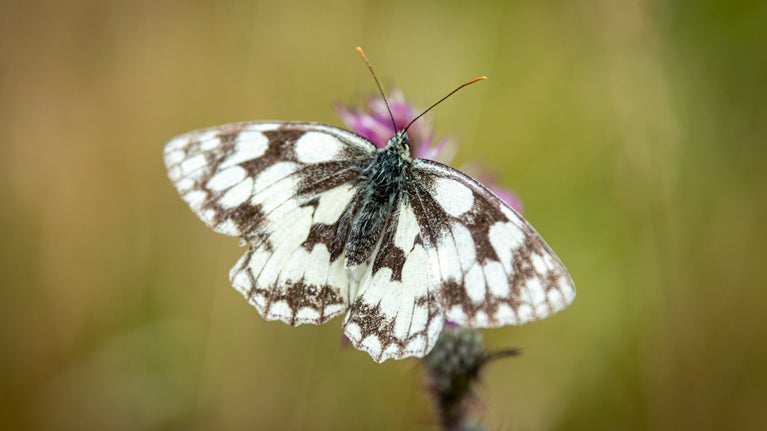Butterfly numbers at historic forest hit 17 year high
- Published:
- 15 August 2025

National Trust rangers at Hatfield Forest in Essex are celebrating a bumper year for butterflies as the number of species recorded reaches a 17-year high.
Hatfield Forest National Nature Reserve is home to 24 species of butterfly and early cumulative numbers are at a level not seen for many years with numbers of the marbled-white and small heath butterflies particularly high, with sightings of the elusive purple emperor also on the increase.
Staff and volunteers for the conservation charity will continue their surveys throughout the summer, but early numbers are reaching levels not seen for the last two decades. While the recent hot and dry spring has contributed to the high numbers, it’s thought that a change in how the landscape is managed has had the biggest impact on boosting numbers. Habitat loss is the number one reason for the dip in butterfly numbers in Britain, with some species having very specific needs to thrive and breed.
James Rowland, National Trust Operations Manager at Hatfield Forest said: “Hatfield has been a working forest for centuries and to this day continues to provide timber and hay for the local area. It’s our job to manage the landscape so it’s the very best it can be for nature. As a National Nature Reserve and Site of Special Scientific Interest it’s home to a vast array of wildlife including rare species of wildflowers, invertebrates, small mammals, reptiles, lichen and fungi, which thrive in the ancient forest and wood pasture habitats.”
“Grassland management is an important part of how we manage the landscape. Two years ago, we decided to make a small change to managing this habitat and since then we’ve seen numbers soar.
“Each year the grass, including the wildflowers, would be mechanically cut in June, but by delaying this as long as possible, to late July into August, we’re allowing flowering species to remain in flower for longer, providing greater benefit to nectar reliant species. Even plants such as thistle and ragwort, which can outcompete other flora species without some level of control, are extremely valuable for butterflies and other pollinators, so we’ve been allowing them to remain in flower as long as possible and only cutting at the point they turn to seed.”
As well as mechanically cutting the grass, a herd of Red Poll cattle play a vital role in creating the best conditions for wildflowers to grow.
James continued: “The herd of Red Poll cattle at Hatfield Forest play a key role in helping to create the best conditions. When cattle graze, not only do they help keep scrub and other dominant plants under control, they help break up the compacted soil. For the last few years we’ve made the move to retain a small number to graze over the winter months to help suppress the growth of scrub species like bramble.
“We’re finding that the presence of the cattle during this period of the year is also helping to prevent a thick thatch of plant matter from smothering next spring’s growth of grass and wildflowers.”
“As our summers get hotter and drought-like conditions become more common, it’s more crucial than ever to sustain a nectar source for our pollinators. During a peak dry spell, many grassland species quickly start to decline and our hardiest species like thistle and ragwort can be a lifeline to many invertebrates.”
Official records at the Forest began in 2008 but annual surveys have been carried out by staff and volunteers at the ancient forest for more than 50 years. The counts have provided one of the most comprehensive data sets for butterfly conservation in the UK. Every week, between April and September, the team walk the same transects through the forest, recording what they see. For those who help carry out the surveys, this record year has been welcomed.
Butterfly survey volunteer, Christine Hemming, said: “It’s been exciting to see so many butterflies this year after the dip in numbers last year. I’ve been volunteering at Hatfield Forest for 13 years and spend most of my time surveying the butterflies, but I’ve never seen so many as early in the year. The forest is such a wonderful place for all sorts of wildlife, but the butterflies are my favourite. Seeing them dance amongst the grass is such a wonderful sight.
"We’ve seen so many more butterflies like silver-washed fritillary and the purple emperor, species you don’t see in your garden and the silver-washed fritillary, marbled-white as well as the magnificent purple emperor, which are not often seen in Essex.”
Each year, the numbers recorded feed into the UK Butterfly Monitoring Scheme which is celebrating its 50th survey season this year.
Since the 1970s, 80% of butterfly species have declined and the unpredictability of the weather and climate will continue to have an impact on the long-term picture. Pollinators like butterflies are vital to a healthy and robust ecosystem so this news is encouraging, and shows that small changes to habitat management can have a big impact when it comes to supporting nature.